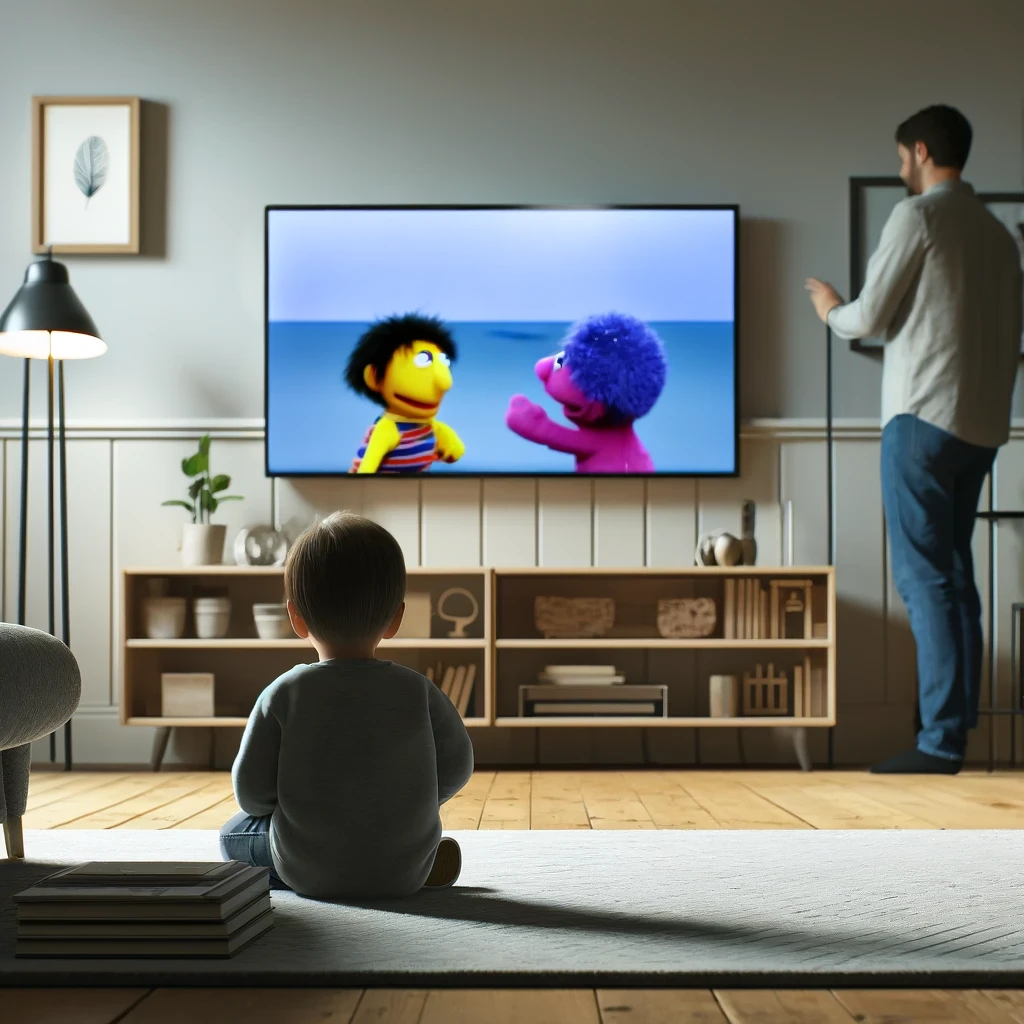Balancing Screen-Time: Enhancing Child Development Through Deferred Imitation
In today's digital age, screens have become an integral part of parents’ lives, presenting both opportunities and challenges with respect to raising young children. Conversely, human evolution, barring negative environmental externalities or genetic disabilities, has made every child a natural-born learner, keenly observing and mimicking the natural world around them without the use of technological crutches. This inherent capability, known as deferred imitation, refers to the ability to replicate observed actions after a delay. Understanding and leveraging this core component of cognitive development can significantly enhance a parent’s positive role in early childhood education."
In this post we give a background on the concept of deferred imitation and explore the nuances in balancing screen time for various age groups. In doing so we provide evidence-based examples and illuminate insights for parents that can enhance the cognitive and social development of children.
What is Deferred Imitation?
Deferred imitation is the ability to replicate actions observed earlier after a delay. For instance, a child might pretend to stir a pot while playing after watching their parent cook hours before.
Other Examples of Deferred Imitation
- Example 1: A toddler copying their parent's cooking gestures after observing them prepare a meal earlier in the day.
- Example 2: A child reenacting a scene from a favorite TV show while playing.
- Example 3: A kindergartener mimicking a teacher’s instructions during independent playtime.
The science behind deferred imitation
As early as the 1960s deferred imitation was thought to first manifest in children around the ages of 18 to 24 months. At that time renowned developmental psychologist Jean Piaget argued that deferred imitation was a vital indicator of memory and representational thought processes in toddlers. For example, a child might see their parent waving goodbye and later repeat the gesture during play. This ability highlighted their observational learning skills but also their capacity to form and recall memories. Piaget famously argued that infants under 18 months lacked the capacity for mental representations, rendering them unable to perform genuine imitation. However, subsequent research challenged this assertion when it was found that 14-month-old infants could imitate a new action (such as separating parts of a toy) a day later very easily without prior practice. Furthermore, later research amazingly demonstrated that 3-month-olds can successfully imitate actions they observed only once three months prior, even without further demonstration, highlighting the maturity of their memory systems to support deferred imitation.
What are positive deferred imitation actions you want your kids to imitate?
We provide a few examples of positive deferred imitation actions that parents can demonstrate to their kids across each of the developmental domains for their babies, toddlers, or preschoolers.
| Developmental Domain | Age Group | Activity Description |
|---|---|---|
| Comprehension Skills | Babies | Object Permanence Play: Use a toy to play peek-a-boo, demonstrating that objects still exist even when out of sight. |
| Toddlers | Story Retelling: Ask your toddler to retell a story in their own words later in the day to enhance narrative recall. | |
| Preschoolers | Problem Solving Scenarios: Solve a puzzle or find a lost item and observe your little one applying similar strategies later. | |
| Language Skills | Babies | Naming Objects: Consistently name objects around the house to associate words with objects. |
| Toddlers | Descriptive Play: Describe actions vividly during play, such as building an enormous tower. | |
| Preschoolers | Interactive Storytelling: Create stories together, then have your child tell the story to another person. | |
| Mathematic Skills | Babies | Basic Patterns: Create simple patterns with blocks or toys for early pattern recognition. |
| Toddlers | Simple Measurement Activities: Use blocks to demonstrate basic measurement concepts. | |
| Preschoolers | Math Story Problems: Solve math problems using real-life scenarios. | |
| Memory Skills | Babies | Object Hide and Seek: Hide a toy and find it repeatedly to encourage memory of location. |
| Toddlers | Toy Placement Recall: Place toys in specific locations and ask your little one to return them later to boost spatial memory. | |
| Preschoolers | Story Recall: After reading, ask your little one to recall details or the sequence of events. | |
| Motor Skills | Babies | Clapping Hands: Clap hands while singing to enhance hand-eye coordination. |
| Toddlers | Drawing Shapes: Draw shapes and have your little one trace or replicate them, enhancing fine motor skills. | |
| Preschoolers | Craft Projects: Engage in crafting, requiring cutting, gluing, and assembling to refine motor skills. | |
| Visual-Spatial Reasoning Skills | Babies | Mirror Play: Show how to make faces or point to body parts in mirrors, to enhance self-awareness and spatial reasoning. |
| Toddlers | Puzzle Solving: Solve simple puzzles together, to enhance spatial reasoning. | |
| Preschoolers | Map Reading: Introduce basic maps, encouraging your little one to find items or locations and boost spatial navigation skills. | |
| Cognition Skills | Babies | Cause and Effect Toys: Use toys that require actions to produce effects, like a pop-up toy. |
| Toddlers | Decision Games: Play simple games that require choosing between options to enhance decision-making skills. | |
| Preschoolers | Strategic Games: Play games such as checkers or simple card games to teach basic strategies. |
The tension between deferred imitation and screen-time
The tension between deferred imitation in kids and digital screen time primarily revolves around concerns that excessive screen time might impact the development of children's imitation skills, which are crucial for learning and cognitive development.
When is screen-time appropriate and who is it appropriate for?
The appropriate use of screen time for children varies significantly based on their age, the quality of the interaction
Age recommendations from the American Academy of Pediatrics
- Under 18 Months: The American Academy of Pediatrics (AAP) advises against any screen time for children under 18 months, except for live video chatting with family and friends. This is because infants at this age are unable to understand what they are seeing on screens and need direct interaction with their environment to help develop their senses and motor skills.
- 18 Months to 2 Years: For toddlers in this age group, screen time should be very limited, and if introduced, it should only involve high-quality programming. The AAP recommends that parents watch alongside their children to help them understand and interact with the content.
- 2 to 5 Years: At this stage, children may benefit from a maximum of one hour of screen time per day. Similar to the situation with younger children, the content should be educational and ideally viewed together with an adult to enhance understanding.
- 6 Years and Older: For older children, consistent limits on both the amount of screen time and the type of media consumed are crucial. It’s important to ensure that screen time does not take away from essential activities such as sleep, physical exercise, and in-person interactions.
The quality of the interaction -- a matter of context and content
The impact of screen time also heavily depends on what children are watching and how they are engaging with the content. Educational programs that encourage viewer interaction and are specifically designed for learning can be beneficial, whereas passive consumption of entertainment can be less productive. Parental involvement is key in ensuring that screen time is a positive experience. Engaging with children during their screen time, discussing the content, and relating it to real-world experiences can greatly enhance the educational value of media.
Two programs on television and streaming platforms that we recommend that parents use with their preschoolers are Numberblocks and Sesame Street.
Numberblocks
Numberblocks features characters that are anthropomorphized numbers who join together and split apart to demonstrate addition, subtraction, and other mathematical operations.
Several key aspects make "Numberblocks" beneficial:
-
Visual Learning: The show uses brightly colored characters and engaging storylines to visualize mathematical concepts, which can help children understand abstract ideas more concretely.
-
Incremental Learning: The progression of the episodes aligns with typical early childhood math curricula, introducing concepts gradually and building upon previous knowledge, which is effective in scaffolding learning.
-
Engagement and Motivation: By presenting math in a playful and narrative form, "Numberblocks" can increase motivation and interest in mathematics, encouraging children to engage with math outside of the educational setting.
-
Repetition and Reinforcement: Regular exposure to mathematical concepts through repeated viewing can reinforce learning, which is an effective educational technique in early childhood development.
Sesame Street
Since its inception in 1969, "Sesame Street" has been the subject of many studies that demonstrate its positive impact on children's learning and development.
Several key aspects make "Sesame Street" beneficial:
-
Literacy and Numeracy: Studies have shown that "Sesame Street" improves children's abilities in literacy and numeracy. This is largely due to the show's focus on core pre-school and early elementary educational content through engaging formats that include songs, stories, and characters that children find appealing.
-
Social and Emotional Skills: "Sesame Street" also aids in the development of social skills. It teaches children about emotions, empathy, and cooperation through its diverse cast of characters, both human and Muppets.
-
Cultural and Health Awareness: The show has been pivotal in teaching children about different cultures and social norms, as well as health-related topics such as nutrition, hygiene, and mental health.
-
Long-term Educational Benefits: A landmark study published in the Journal of Applied Developmental Psychology found that exposure to "Sesame Street" at an early age had a positive long-term impact on children's educational success and even their future career paths.
In summary, while screen time can be a useful tool for education and development when used appropriately, it is crucial to monitor the amount and quality of media that children are exposed to. The Lifora platform is unique in that you as a parent use our evidence-based tools to determine what physical materials you need to prepare for today's activities and then engage with your kids in a face-to-face manner in the physical world. No screen-time is needed for your kids.
© 2025 ‐ Didactiic




